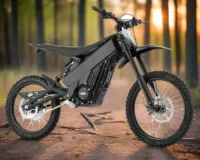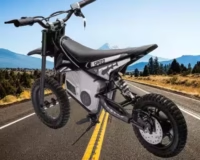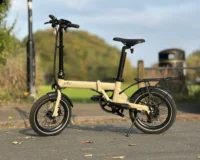Electric bikes (e-bikes) have surged in popularity, celebrated for their eco-friendliness, commuting efficiency, and recreational appeal. Blog posts and articles abound, dissecting their technical specifications, environmental benefits, and the sheer joy of effortlessly conquering hills. Yet, beneath this well-trodden surface lies a fascinating, less-explored narrative: the profound social and cultural impact of e-bikes on niche communities and specific demographics.
These are the stories of quiet revolutions, where e-bikes are not just modes of transport but catalysts for independence, connection, and unexpected cultural shifts. This in-depth analysis will delve into these underexplored facets, demonstrating how e-bikes are far more than just bicycles with motors; they are instruments of social change.
I. The Unexpected Embrace: E-Bikes in Amish Communities
Perhaps one of the most surprising and least-blogged-about phenomena is the quiet integration of e-bikes into certain Old Order Amish communities. At first glance, this seems contradictory to a lifestyle known for its deliberate eschewal of modern technology, particularly anything powered by external electricity. However, a deeper look reveals a pragmatic adaptation that aligns with core Amish values.
The Amish Philosophy of Technology:
The Amish approach to technology is not a blanket rejection but a careful, communal discernment process. New technologies are evaluated based on their potential to strengthen or weaken community ties, promote self-sufficiency, and maintain a separation from the “world.” Anything that fosters pride, idleness, or dependency on external systems is typically rejected.
Why E-Bikes Fit (for Some):
Self-Sufficiency and Community Reliance: Traditional Amish transportation relies on horses and buggies or pedal bicycles. For longer distances, particularly for work or visiting distant community members, hiring an “English” (non-Amish) driver becomes necessary. E-bikes offer a means to cover greater distances and challenging terrain (like hills) without resorting to external, car-based transport. This reinforces self-reliance within the community and reduces dependence on outsiders. As one Amish e-bike shop owner noted, it’s “a lot quicker to jump on your bike and go into town than it is to bring your horse into the barn, harness it to the buggy, and go.” This efficiency for work commutes, often spanning 8-10 miles, is a significant driver.
Physicality and Accessibility:
While pedal bikes are common, the physical exertion required for long distances or hilly topography can be prohibitive, especially for older community members or those with physical limitations. E-bikes allow them to remain mobile and engaged in community life, farming, or craft-based work, without the same physical strain. This promotes active participation across all age groups.
Power Source Alignment:
Crucially, many Amish communities that permit e-bikes often power them using locally generated solar electricity. This aligns with their preference for self-contained systems and avoids reliance on the public grid, which is seen as a symbol of the “outside world.” Some communities are even building their own e-bikes and tricycles, further enhancing their self-sufficiency.
Maintaining Simplicity:
Unlike cars, e-bikes are relatively simple machines. They don’t have complex computer systems, require specialized fuels from external sources, or present the same level of exposure to secular culture that cars might. They blend more seamlessly into a non-motorized landscape, preserving a desired aesthetic and lifestyle.
Challenges and Divisions:
It’s important to note that the adoption of e-bikes is not universal across all Amish orders. There are ongoing debates and varying interpretations of their acceptability. Some bishops and communities remain staunchly opposed, fearing that even this modest technological integration could be a slippery slope towards greater assimilation and erosion of traditional values. Concerns exist about the potential for increased individualism (traveling further from the community for non-essential purposes) or a subtle shift away from the discipline of physical labor. These internal discussions highlight the careful, often slow, process of technological assimilation within the Amish framework.
II. Bridging Distances: E-Bikes in Rural and Remote Areas
While urban centers often hog the e-bike spotlight, their transformative impact on rural and remote areas is equally, if not more, significant, yet rarely deeply explored. In regions often underserved by public transport and characterized by spread-out populations and challenging terrains, e-bikes are quietly revolutionizing connectivity and daily life.
Addressing Rural Mobility Gaps:
Limited Public Transport:
Many rural areas lack comprehensive public transportation networks, making car ownership almost a necessity. For those without access to a car, or who cannot drive (e.g., young people, older adults, or those with disabilities), mobility can be severely restricted. E-bikes offer a viable, affordable alternative for local travel.
Overcoming Topography and Distance:
Rural landscapes often feature hills, unpaved roads, and longer distances between destinations like towns, farms, or neighbors. Traditional cycling can be exhausting and impractical. The pedal-assist feature of e-bikes makes these journeys manageable, opening up greater access to services, social events, and employment opportunities.
Economic Empowerment:
For small business owners, farmers, and artisans in rural areas, e-bikes can facilitate transport of goods to local markets or enable visits to clients, reducing reliance on expensive fuel or cumbersome vehicle maintenance. This boosts local economies and can even create new micro-enterprises.
Community Cohesion:
E-bikes can help bridge geographical distances that often challenge social interaction in rural communities. By making it easier to visit neighbors, attend local events, or simply go for a ride, e-bikes foster stronger community ties and reduce social isolation.
Environmental and Cost Benefits:
Reduced Reliance on Fossil Fuels:
In car-dependent rural areas, e-bikes offer a sustainable alternative, reducing carbon footprints and promoting cleaner air. This aligns with growing environmental consciousness even in less urbanized settings.
Cost Savings:
The upfront cost of an e-bike is significantly lower than a car, and operating costs (electricity vs. fuel, maintenance) are minimal. This financial accessibility makes e-bikes a game-changer for lower-income households in rural areas.
III. Reclaiming Independence: E-Bikes for the Elderly and Those with Mobility Issues
One of the most heartwarming and impactful applications of e-bikes is their ability to restore mobility, independence, and a sense of freedom to older adults and individuals facing physical limitations or disabilities. Often sidelined in mainstream cycling narratives, these demographics are experiencing a quiet revolution.
Empowering Older Adults:
Overcoming Physical Barriers: As we age, physical limitations like joint pain, reduced stamina, or balance issues can make traditional cycling challenging or impossible. E-bikes, with their adjustable pedal assist and often step-through frames, mitigate these barriers. Riders can choose the level of assistance they need, allowing them to cycle without overexertion.
Maintaining Active Lifestyles:
E-biking provides a low-impact form of exercise that contributes to cardiovascular health, strengthens muscles, and improves balance – crucial for healthy aging. It allows older adults to stay active outdoors, promoting both physical and mental well-being.
Social Connection and Engagement:
E-bikes enable older adults to participate in group rides, visit friends and family, and access community events more easily. This combats social isolation, a significant health risk, and fosters a sense of belonging.
Increased Confidence and Mental Health:
The ability to cycle independently, perhaps for the first time in years, can significantly boost self-esteem and confidence. This newfound freedom often translates to improved mental health, reducing feelings of depression and anxiety associated with limited mobility. The joy of being outdoors and experiencing the environment actively has well-documented psychological benefits.
Adaptive E-Bikes for Disabilities:
Diverse Adaptive Solutions: The market for adaptive bikes, often electric-assisted, is growing. These include:
Tricycles: Offering enhanced stability for those with balance issues.
Recumbent Trikes: Allowing a more relaxed, seated position, often beneficial for back or neck problems.
Handcycles:For individuals with lower limb paralysis, allowing propulsion by hand with electric assist.
Wheelchair Bikes: Specially designed frames that can transport a wheelchair-bound passenger.
Side-by-Side Tandems: Enabling a person with a disability to cycle alongside a companion, facilitating communication and shared experience.
Pedal-Assist Customization: Adaptive e-bikes often feature highly customizable pedal-assist systems, allowing precise control over power delivery to match individual abilities and needs. Options like starting aid provide an extra boost from a standstill, critical for safety and confidence.
Integration and Inclusion: By providing accessible and enjoyable cycling options, adaptive e-bikes contribute to the greater integration and inclusion of people with disabilities in recreational activities and community life. They move beyond mere transport to offer a powerful tool for therapy, freedom, and social participation.
IV. The Backbone of the Gig Economy: E-Bikes for Delivery and Services
While the image of a food delivery rider on a scooter is common, the increasing adoption of e-bikes by gig economy workers, particularly for last-mile delivery, presents a dynamic and evolving socio-economic narrative. This shift, often happening in dense urban environments, highlights efficiency, accessibility, and the changing nature of urban labor.
Operational Efficiency and Economic Advantages:
Navigating Urban Congestion: E-bikes are highly maneuverable, allowing riders to bypass traffic jams, use bike lanes, and take shortcuts that cars or even motorbikes cannot. This translates to faster delivery times, crucial for the gig economy’s emphasis on speed and efficiency.
Lower Operating Costs:For riders, the cost savings are substantial. E-bikes eliminate fuel costs (a major expense for scooter or car-based delivery), reduce maintenance needs, and typically avoid parking fees. This directly increases a rider’s net earnings, making gig work more financially viable.
Accessibility to Work: E-bikes lower the barrier to entry for delivery work. Unlike motorcycles, e-bikes often don’t require a special license (depending on local regulations), broadening the pool of potential workers. This creates employment opportunities for individuals who might not have access to a car or motorbike.
Environmental Benefits for Urban Areas:The widespread use of e-bikes for delivery significantly reduces urban emissions and noise pollution. This aligns with city goals for greener transport and improved air quality.
Enhanced Carrying Capacity:Electric cargo bikes (e-cargo bikes) are increasingly being used for larger deliveries, replacing vans and small trucks. Their electric assist makes it feasible to transport substantial loads, further reducing urban congestion and emissions.
Social Impact on Workers:
Reduced Physical Strain: Compared to traditional cycling, e-bikes significantly reduce the physical exertion required for long shifts and heavy loads, improving rider comfort and potentially extending their working careers.
Flexible Work and Autonomy:The independence offered by e-bikes allows riders greater flexibility in their schedules and routes, aligning with the “gig” nature of the work.
Potential for Entrepreneurship: Some riders might transition from working for platforms to establishing their own local delivery services using e-bikes, fostering micro-entrepreneurship.
Challenges and Future Considerations:
Infrastructure:Adequate bike lanes, secure parking, and charging infrastructure are essential for supporting a robust e-bike delivery ecosystem.
Worker Protections: As e-bikes become more central to the gig economy, discussions around fair pay, benefits, and worker protections for e-bike couriers will become increasingly important.
Safety: The increased speed and weight of e-bikes compared to traditional bicycles necessitate careful consideration of rider safety and urban planning for shared spaces.
V. The Subtle Shift: E-Bikes and the Evolution of Cycling Culture
Beyond their practical applications, e-bikes are subtly but fundamentally reshaping cycling culture itself. Once dismissed as “cheating” by purists, e-bikes are now broadening the appeal of cycling, fostering new communities, and redefining what it means to be a cyclist.
Democratizing Cycling:
Lowering Barriers to Entry: Traditionally, cycling, especially for recreation or long distances, required a certain level of fitness and endurance. Hills, headwinds, and fatigue were deterrents. E-bikes eliminate these barriers, making cycling accessible to a much wider demographic, including those new to cycling, returning after a long break, or with varying fitness levels.
Inclusion in Group Rides: The “performance gap” between riders of different fitness levels on traditional bikes can often lead to some feeling left behind. E-bikes effectively level the playing field, allowing friends, partners, and multi-generational families to ride together at a comfortable pace, fostering social cohesion and shared experiences.
Expanding Geographic Reach: With less physical effort, riders can explore more challenging terrains, venture further afield, and discover new routes that were previously inaccessible on a traditional bike. This expands the horizons of recreational cycling.
Emergence of New Communities:
E-Bike Specific Clubs:As the e-bike demographic grows, so do dedicated e-bike clubs and communities. These groups often focus on leisurely rides, scenic routes, and social interaction rather than intense performance, fostering a different kind of camaraderie.
Bridging the Divide: While some “traditional” cyclists may still hold reservations, many are increasingly recognizing the benefits and inclusivity of e-bikes, leading to a more integrated cycling community. Events and trails are increasingly welcoming both traditional and electric cyclists.
Redefining the “Cyclist” Identity:
Focus on Enjoyment over Effort: For many e-bike users, the emphasis shifts from purely physical exertion to the sheer enjoyment of the ride, the scenery, and the social interaction. This redefines cycling as an accessible leisure activity, not just a strenuous sport.
Commuting as a Lifestyle Choice: E-bikes make cycle commuting feasible for a larger segment of the population, including those who previously found it too arduous or sweaty. This transforms commuting from a chore into an active, enjoyable part of the day, with positive impacts on mood and well-being.
VI. Beyond the Physical: The Psychological and Mental Health Benefits of E-Bike Ownership
While the physical benefits of e-biking (exercise, cardiovascular health) are well-documented, the profound psychological and mental health advantages are often understated. E-bikes are proving to be powerful tools for stress reduction, mood enhancement, and fostering a deeper connection with the environment.
Combating Stress and Anxiety:
Endorphin Release: Like any physical activity, e-biking triggers the release of endorphins, natural mood elevators that can alleviate symptoms of stress and anxiety. Even with pedal assist, the body is still engaged in moderate physical activity.
Mindfulness and Focus: The act of cycling requires focus on the road, surroundings, and immediate sensations. This can serve as a form of “active meditation,” diverting attention from stressors and promoting a sense of mindfulness and presence.
Escape and Exploration: E-bikes provide an easy means to escape daily routines, explore new environments, and immerse oneself in nature. This change of scenery and sense of adventure can be incredibly therapeutic, fostering relaxation and mental clarity.
Boosting Mood and Self-Esteem:
Sense of Accomplishment:Conquering a challenging route, reaching a new destination, or simply completing a longer ride on an e-bike can provide a significant sense of accomplishment and pride, contributing to a positive self-image.
Increased Independence: For individuals whose mobility might be limited by age, health, or disability, the renewed ability to cycle independently offers a powerful boost to self-esteem and a feeling of empowerment.
Social Connection: Participating in group rides or simply encountering others on trails fosters social interaction and a sense of belonging, directly combating loneliness and improving mood.
Cognitive Benefits:
Improved Concentration and Reflexes: Navigating varied terrains and making real-time decisions (braking, turning) during a ride keeps the mind active and responsive, potentially enhancing cognitive functions.
Enhanced Creativity: Exploring new routes and experiencing the environment from a different perspective can stimulate creativity and open the mind to new ideas.
Green Exercise Effect: Research consistently shows that outdoor exercise (like e-biking) yields greater reductions in depressive symptoms than indoor activities. Exposure to natural light, fresh air, and green spaces has a direct positive impact on mental well-being.
Conclusion: The Unsung Versatility of the Electric Bicycle
The common discourse surrounding electric bikes often gravitates towards their role in urban commuting, their environmental credentials, and the pure thrill of effortless speed. However, by looking deeper into their integration into niche communities and their profound impact on specific demographics, a richer, more compelling narrative emerges. From the fields of Amish country to the quiet lanes of rural villages, from empowering seniors to reclaim their mobility to providing a sustainable backbone for the gig economy, and from fostering new social connections to profoundly benefiting mental well-being, e-bikes are proving to be far more versatile and transformative than many realize.
These are not just technological marvels; they are social catalysts. They are democratizing cycling, fostering independence, strengthening communities, and subtly reshaping the fabric of everyday life in ways that are often overlooked. As the e-bike revolution continues, it is crucial to shine a light on these less-blogged-about stories, revealing the quiet, yet powerful, ways in which electric bikes are indeed changing the world, one ride at a time. For content creators, this underexplored territory offers a wealth of authentic, impactful, and SEO-rich narratives that resonate deeply with human experience and societal progress.







